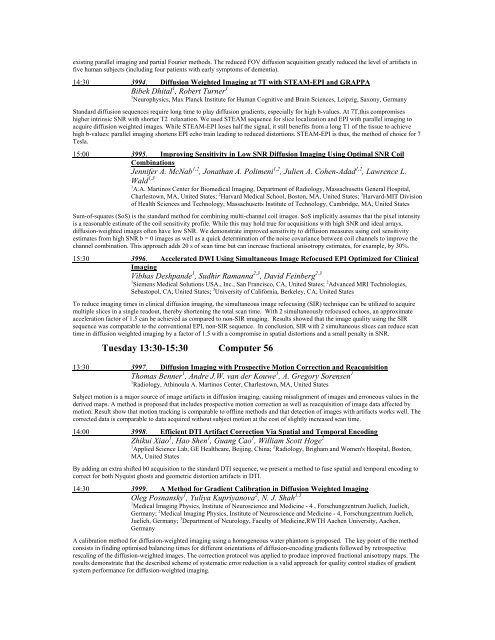ELECTRONIC POSTER - ismrm
ELECTRONIC POSTER - ismrm
ELECTRONIC POSTER - ismrm
You also want an ePaper? Increase the reach of your titles
YUMPU automatically turns print PDFs into web optimized ePapers that Google loves.
existing parallel imaging and partial Fourier methods. The reduced FOV diffusion acquisition greatly reduced the level of artifacts in<br />
five human subjects (including four patients with early symptoms of dementia).<br />
14:30 3994. Diffusion Weighted Imaging at 7T with STEAM-EPI and GRAPPA<br />
Bibek Dhital 1 , Robert Turner 1<br />
1 Neurophysics, Max Planck Institute for Human Cognitive and Brain Sciences, Leipzig, Saxony, Germany<br />
Standard diffusion sequences require long time to play diffusion gradients, especially for high b-values. At 7T,this compromises<br />
higher intrinsic SNR with shorter T2 relaxation. We used STEAM sequence for slice localization and EPI with parallel imaging to<br />
acquire diffusion weighted images. While STEAM-EPI loses half the signal, it still benefits from a long T1 of the tissue to achieve<br />
high b-values: parallel imaging shortens EPI echo train leading to reduced distortions. STEAM-EPI is thus, the method of choice for 7<br />
Tesla.<br />
15:00 3995. Improving Sensitivity in Low SNR Diffusion Imaging Using Optimal SNR Coil<br />
Combinations<br />
Jennifer A. McNab 1,2 , Jonathan A. Polimeni 1,2 , Julien A. Cohen-Adad 1,2 , Lawrence L.<br />
Wald 1,3<br />
1 A.A. Martinos Center for Biomedical Imaging, Department of Radiology, Massachusetts General Hospital,<br />
Charlestown, MA, United States; 2 Harvard Medical School, Boston, MA, United States; 3 Harvard-MIT Division<br />
of Health Sciences and Technology, Massachusetts Institute of Technology, Cambridge, MA, United States<br />
Sum-of-squares (SoS) is the standard method for combining multi-channel coil images. SoS implicitly assumes that the pixel intensity<br />
is a reasonable estimate of the coil sensitivity profile. While this may hold true for acquisitions with high SNR and ideal arrays,<br />
diffusion-weighted images often have low SNR. We demonstrate improved sensitivity to diffusion measures using coil sensitivity<br />
estimates from high SNR b = 0 images as well as a quick determination of the noise covariance between coil channels to improve the<br />
channel combination. This approach adds 20 s of scan time but can increase fractional anisotropy estimates, for example, by 30%.<br />
15:30 3996. Accelerated DWI Using Simultaneous Image Refocused EPI Optimized for Clinical<br />
Imaging<br />
Vibhas Deshpande 1 , Sudhir Ramanna 2,3 , David Feinberg 2,3<br />
1 Siemens Medical Solutions USA., Inc., San Francisco, CA, United States; 2 Advanced MRI Technologies,<br />
Sebastopol, CA, United States; 3 University of California, Berkeley, CA, United States<br />
To reduce imaging times in clinical diffusion imaging, the simultaneous image refocusing (SIR) technique can be utilized to acquire<br />
multiple slices in a single readout, thereby shortening the total scan time. With 2 simultaneously refocused echoes, an approximate<br />
acceleration factor of 1.5 can be achieved as compared to non-SIR imaging. Results showed that the image quality using the SIR<br />
sequence was comparable to the conventional EPI, non-SIR sequence. In conclusion, SIR with 2 simultaneous slices can reduce scan<br />
time in diffusion weighted imaging by a factor of 1.5 with a compromise in spatial distortions and a small penalty in SNR.<br />
Tuesday 13:30-15:30 Computer 56<br />
13:30 3997. Diffusion Imaging with Prospective Motion Correction and Reacquisition<br />
Thomas Benner 1 , Andre J.W. van der Kouwe 1 , A. Gregory Sorensen 1<br />
1 Radiology, Athinoula A. Martinos Center, Charlestown, MA, United States<br />
Subject motion is a major source of image artifacts in diffusion imaging, causing misalignment of images and erroneous values in the<br />
derived maps. A method is proposed that includes prospective motion correction as well as reacquisition of image data affected by<br />
motion. Result show that motion tracking is comparable to offline methods and that detection of images with artifacts works well. The<br />
corrected data is comparable to data acquired without subject motion at the cost of slightly increased scan time.<br />
14:00 3998. Efficient DTI Artifact Correction Via Spatial and Temporal Encoding<br />
Zhikui Xiao 1 , Hao Shen 1 , Guang Cao 1 , William Scott Hoge 2<br />
1 Applied Science Lab, GE Healthcare, Beijing, China; 2 Radiology, Brigham and Women's Hospital, Boston,<br />
MA, United States<br />
By adding an extra shifted b0 acquisition to the standard DTI sequence, we present a method to fuse spatial and temporal encoding to<br />
correct for both Nyquist ghosts and geometric distortion artifacts in DTI.<br />
14:30 3999. A Method for Gradient Calibration in Diffusion Weighted Imaging<br />
Oleg Posnansky 1 , Yuliya Kupriyanova 2 , N. J. Shah 1,3<br />
1 Medical Imaging Physics, Institute of Neuroscience and Medicine - 4 , Forschungzentrum Juelich, Juelich,<br />
Germany; 2 Medical Imaging Physics, Institute of Neuroscience and Medicine - 4, Forschungzentrum Juelich,<br />
Juelich, Germany; 3 Department of Neurology, Faculty of Medicine,RWTH Aachen University, Aachen,<br />
Germany<br />
A calibration method for diffusion-weighted imaging using a homogeneous water phantom is proposed. The key point of the method<br />
consists in finding optimised balancing times for different orientations of diffusion-encoding gradients followed by retrospective<br />
rescaling of the diffusion-weighted images. The correction protocol was applied to produce improved fractional anisotropy maps. The<br />
results demonstrate that the described scheme of systematic error reduction is a valid approach for quality control studies of gradient<br />
system performance for diffusion-weighted imaging.
















